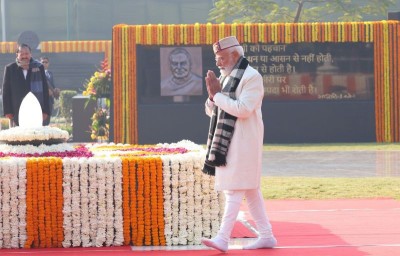
Bihar: Maoists Surge
On March 8, 2017, four CPI-Maoist cadres were killed in an encounter with personnel of the 205th battalion of CoBRA (Commando Battalion for Resolute Action) of the Central Reserve Police Force (CRPF) in the forest area of Baskatwa under Gurpa Police Station in Gaya District. Acting on a tip-off about a meeting of top Maoist leaders in the area, the Security Forces (SFs) launched an operation and, on seeing SFs, the rebels opened fired, leading to an encounter in which the four Maoists were killed. SFs recovered four bodies of the rebels along with their arms. The arms included two Indian Small Arms System (INSAS) assault rifles, one Self Loading Rifle (SLR) and one AK-47 assault rifle. The slain Maoists were identified as Anil aka Deepak, 'zonal commander' of 'Magadh area committee', Rajesh Ravidas, a 'sub-zonal commander'; Nepali Yadav and Uttam.
On March 1, 2017, cadres of the Tritiya Prastuti Committee (TPC) killed a villager, identified as Jitendra Kharwar, at Goreya village in Rohtas District. TPC is a CPI-Maoist splinter group and operates out of Jharkhand, the neighboring State.
On February 21, 2017, Mantu Khaira, 'zonal-commander' of the CPI-Maoist was killed in an anti-Maoist operation in Dahibara forests under Anandpur in Banka District. SFs recovered two SLRs, an AK-47 and some grenades at the encounter site.
On February 20, 2017, CPI-Maoist cadres killed one Sunil Yadav at Champapur village in Lakhisarai District. Sunil was the husband of the deputy mukhiya (village head) of Champapur village.
On January 30, 2017, Sanjay Pandey, a munshi (accountant) with Raj Kumar Constructions, engaged in construction of rural roads, was beheaded for not paying extortion money to the Naxals [Left Wing Extremists (LWEs)] in Jamui District. Maoist leaflets found near the dead body declared that those executing Government plans with the help of the Police and without obtaining CPI-Maoist permission would meet a similar fate.
According to partial data collated by the South Asia Terrorism Portal (SATP), Bihar has already accounted for at least nine Maoist-linked fatalities, including four civilians and five Maoists, in the current year (data till March 19, 2017).During the corresponding period of 2016, the number of such fatalities stood at eight (one civilian, two SF personnel and five Maoists).
Indeed, the declining trend in fatalities recorded in the State since 2011 registered a sharp reversal in 2016. According to the SATP database, 32 persons, including eight civilians, 15 SF personnel and nine Maoists, were killed in the State in 2016, in comparison to nine persons, including four civilians, three SF personnel and two Maoists, killed in 2015.
The surge in civilian fatalities, which doubled in 2016 as against 2015, is worrisome indeed. Worse, SFs appear to have been pushed on the back foot in the State. The Maoists continued to improve their kill ratio against SFs, at 1:1.66 in their favour, as against 1:1.5 archived in 2015.
The surge in Maoist-related violence in 2016 was substantially the result of three major incidents (each involving three or more fatalities), in which three civilians, 10 SF personnel and seven Maoists were killed, in comparison to no major incident registered in 2015. The most significantof these was recorded on July 18, 2016, when 10 COBRA commandos were killed and another five injured, in a CPI-Maoist orchestrated Improvised Explosive Device (IED) blast and subsequent encounter in the Chakarbanda-Dumarinala forests of Aurangabad District. Three Maoists were also killed in the encounter.
The Aurangabad incident will go a long way in denting the morale of the SF personnel not just in Bihar but across all theatres of LWE conflict in India. The manner in which the Maoists planned and trapped the elite counter-insurgency personnel speaks volumes of the hold the ultras enjoy in the region , across Aurangabad, Gaya and Jamui, the epicentre of Maoist-violence in Bihar. Incidentally, according to SATP data, out of the total of 32 fatalities in the State in 2016, 29 (seven civilians, 13 SF personnel and nine Maoists) were reported from these three Districts alone.
In addition to incidents of killing, the Maoists in Bihar have also escalated other violent activities through 2016, including abduction (two reported incidents in which six persons were abducted), arson (10 incidents), bomb blasts (four occasions), attacks on railway property (three incidents), among others. During 2015, the Maoists were involved in three incidents of abduction in which three persons were abducted, and three incidents of arson. No incident of bomb blast or attack on railway property was recorded during 2015.
The Maoists also issued four bandh (shut down strike) calls on different issues in 2016, in comparison to five such calls in 2015. The Maoists had given three such calls in the State in 2014.
Union Ministry of Home Affairs (UMHA) data confirms the spike in the Maoist-linked incidents in the State in 2016, with 129 Maoist-linked incidents recorded in 2016, as against 110 such incidents in 2015. A total of 163 such incidents were recorded in 2014. Similarly, there was a marginal spike in Maoists involved in attacking economic targets in 2016, with 10 such incidents, as compared to nine such attacks in 2015. A total of 31 such attacks were registered in 2014.
Disturbingly, out of the 38 Districts of the State, 22 Districts - Arwal, Aurangabad, Banka, Begusarai, Bhojpur, East Champaran, Gaya, Jamui, Jehanabad, Kaimur, Khagaria, Lakhisarai, Munger, Muzaffarpur, Nalanda, Nawada, Patna, Rohtas, Sitamarhi, Sheohar, Vaishali and West Champaran -are among the 35 worst LWE- affected Districts identified by the UMHA across the country. According to SATP, Maoist activities were recorded in at least 17 Districts in 2016 as against 22 in 2015.
On March 14, 2017, Kundan Krishnan, Inspector General (IG, Operations), Bihar Police, admitted that there were challenges in carrying out operations in some part of Munger, Lakhisarai and Chakarbandha in Gaya; south GT road in Aurangabad and Gaya Districts, besides Charkapathar and Narganjo in Jamui, owing to the difficult terrain in these areas. He added, "Maoist violence has certainly shown a declining trend in the State. But four Bihar districts along the Jharkhand border, known for their difficult topography, namely, Aurangabad, Gaya, Lakhisarai and Jamui - still have pockets of left-wing extremist (LWE) activity."
Apart from CPI-Maoist, the TPC, also made its presence felt in the State. On January 3, 2016, TPC cadres assaulted two persons, identified as Ramvilas Ram and Ramdeep Ram in Aurangabad District. The fear of a TPC backlash is such that it forced the mukhiya (village head) Ramji Ram not to lodge a Police complaint even though the victims belonged to his family - 70-year-old Ramvilas Ram (father) and Ramdeep Ram (brother). TPC cadres had demanded 20 per cent of the grant sanctioned by the Government for welfare schemes in Ramji's panchayat (village level local self government institution). The March 1, 2017, killing (mentioned above) of a civilian in Rohtas District was the latest TPC-related incident.
Another, Maoist splinter, People's Liberation Front of India (PLFI), which also operates out of Jharkhand, has been active in Bihar. Additional Director General of Police (ADG, Headquarters), Sunil Kumar, noted, on March 9, 2016, "Looking at the increasing activities of the PLFI, the officials of both the States [Bihar and Jharkhand] have decided to share information. Earlier, PLFI was more active in Jharkhand. So, their input will be valuable for us."
Meanwhile, SFs arrested at least 104 LWEs in the State, including two 'area commanders,' two 'zonal commanders' and a 'supreme commander' of the Revolutionary Communist Centre (RCC), in addition to 153 arrests in 2015. Till March 19, 2017, another 11 LWEs had already been arrested in the current year.
SF personnel also recovered a huge amount of arms, ammunition and explosives in Bihar. On September 8, 2016, Police seized a huge consignment of explosives being smuggled from Jharkhand, in the Barachatti Police Station area in Gaya District. The recoveries included 10,350 detonators and 6,500 gelatin sticks. Further, on November 10, 2016, Police uncovered two mini gun factories and recovered a country-made revolver and a large number of arms-making hand-driven machines and barrels at Gorho village under Asarganj Police Station in Munger District.
Under the State's new surrender policy of 2013, in which the Bihar Government provides financial assistance, including up to INR 250,000 to top leaders who surrender; INR 10,000 as immediate assistance and INR 3,000 per month for rehabilitation, as well as rewards for each weapon surrendered, the State recorded the surrender of 24 LWEs in 2016, in addition to seven surrenders in 2015.
Unfortunately, Bihar Police continues to lag in terms of capacities to deal with the evolving challenges created by the Maoists. According to the latest Bureau of Police Research and Development (BPR&D) data, Bihar has 90.68 Police personnel per 100,000 populations, as against a sanction of 119.17, as on January 1, 2016, the worst ratio in the country, and far below the national average of 137.11. The Police/Area Ratio (number of policemen per 100 square kilometers) is 99.61, as against the sanctioned strength of 130.92. The State was found to be lagging in construction of fortified Police Stations, with 40 out of the sanctioned 45 yet to be constructed. By comparison, in neighbouring Jharkhand, out of 73 sanctioned fortified Police Stations, only two were yet to be completed; in Odisha, out of 52 sanctioned fortified Police Stations, 18 remained to be constructed; and in West Bengal, out of 17 fortified Police Stations, just one was yet to be completed. Moreover, 36 of 1,064 Police Stations are without any wireless sets. These are only a sampling of the enveloping deficits that afflict Police capacities in the State.
Significantly, on January 31, 2017, A.R.K. Kini, the Union Secretary (Security) in the Cabinet Secretariat, expressed concern over Bihar Police's failure to implement the Crime and Criminal Tracking Network and System (CCTNS) project, despite the Centre bearing the entire cost of the project. The Centre has already provided INR 250 million out of the total INR 680 million earmarked to the State for this project.
The persistent lack of political sagacity across successive regimes in addressing these issues and deficits has bolstered the Maoists in the State at a time when they are suffering major reverses across most other theatres in the country. The Maoists have demonstrated tremendous resilience in very trying circumstances in the past, and the failure to deal consistently and effectively with them will create opportunities for their consolidation once again, giving them a base in Bihar to engineer a recovery in other parts of the country as well. There is, quite simply, no room for a divergent State approach on this issue, at a time when a nationally coordinated strategy appears to be making significant gains.
Support Our Journalism
We cannot do without you.. your contribution supports unbiased journalism
IBNS is not driven by any ism- not wokeism, not racism, not skewed secularism, not hyper right-wing or left liberal ideals, nor by any hardline religious beliefs or hyper nationalism. We want to serve you good old objective news, as they are. We do not judge or preach. We let people decide for themselves. We only try to present factual and well-sourced news.







